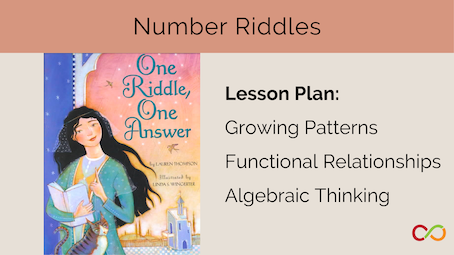Number Riddles: Part 2
Age group
- Junior/Intermediate (Age 9 to 12)
Curriculum Goal
Junior: Number Sense
Use knowledge of numbers and operations to solve mathematical problems encountered in everyday life.
Related Links
Context
- Students should have an understanding of place value and experience with following multi-step math problems.
- This lesson is the second half of a two-part lesson where students will work individually, in pairs, and in small groups. Number Riddles: Part 1.
Materials
- Book: “One Riddle, One Answer” by Lauren Thompson
- Chart paper
- Markers
- Paper
- Pencils
Lesson
- Inform students they will be creating their own math riddle with clues for their classmates to solve. Provide the example from the previous day to remind students what the riddle should look like.
- “I am a three-digit number. My tens place is four times greater than my ones place. My hundreds place is three less than my tens place. The digit in my ones place is odd. What number am I?”
- Give students approximately 15 minutes to create their own magic number riddle.
- Students must first decide their magic number, and then create at least three clues that will lead to the answer.
- Have students record their riddle on a piece of paper. Remind students to attempt the riddle themselves to ensure all the clues make sense for the answer, just like they did when reading One Riddle, One Answer.
- When students have finished creating their riddle, break the class into small groups of three to four students. Have each student from the group take turns presenting their riddle for the other group members to solve.
- Once every group member has had a chance to share and solve their riddle, bring the class back together.
- If some groups finish earlier than others, have the small group members co-construct a math riddle to trade with another group that is finished.
- As a whole group, present the following riddles on chart paper one at a time:
- You must paint the apartment number on plates for 100 apartments which means you will have to paint numbers 1 through 100. How many times will you paint the number 8?
- Answer: 20 times – 8, 18, 28, 38, 48, 58, 68, 78, 80, 81, 82, 83, 84, 85, 86, 87, 88, 89, 98.
- Using only addition, add eight 8s to get the number 1,000.
- Answer: 888 + 88 + 8 + 8 + 8 = 1,000.
- You must paint the apartment number on plates for 100 apartments which means you will have to paint numbers 1 through 100. How many times will you paint the number 8?
- Allow students five minutes per riddle to try and solve them independently then discuss possibilities and mathematical strategies for solving each riddle as a full class before revealing the answers.
Look Fors
- What kind of mathematical reasoning are students doing when trying to solve Aziza’s riddle?
- Do students find additional correct answers for Aziza’s riddle (e.g., zero)?
- What language and level of mathematical reasoning is being used when students create their own Magic Number?
